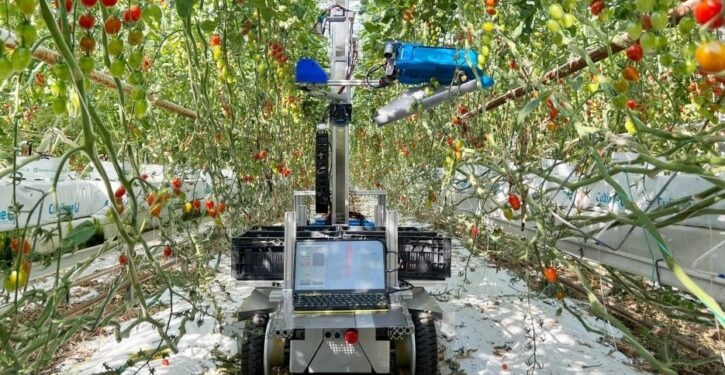
Japan’s agricultural workforce is shrinking due to its low birth rate. To cope with the resulting labor shortage, Japanese farmers are turning to robots equipped with artificial intelligence. The Japan Times reports that “Large-scale greenhouse farmers are leading the way, having begun to use AI-equipped robots developed by venture businesses in ways that seem, more or less, to change the future of cultivating and harvesting agricultural products.” This fall, “a four-wheeled AI robot slowly rolled through the lush green leaves of a plastic greenhouse at a farm in Hanyu,” Japan, “gathering only the ripest cucumbers.” “We were initially afraid that the robot might cut off the cucumber stems, but it moves accurately,” said a greenhouse operator. “We expect much out of the robot now that labor is in such short supply.”
The robot was invented by the Agrist company, and uses a camera and Artificial intelligence to gauge whether it is the correct time to harvest crops. As the Japan Times notes,
The farm leased the automated cucumber harvester from Agrist, which has been developing harvesting robots since its founding in 2019 in Miyazaki Prefecture… The robot checks the size of cucumbers based on images it captures from a camera mounted on the robot, recognizing ripe ones and cutting off between one and three roughly every two minutes before placing them in a case. The robot also accurately positions its arm vis-a-vis cucumbers so as to avoid damaging their stems.
Inaho, an agricultural venture company just south of Tokyo,
has leased an AI-equipped robot to a farm in the Netherlands. It can automatically pick cherry tomatoes in bunches or individually, depending on the mechanism employed. The AI analyzes images and selects multiple tomatoes that are ripe and easy to pick before the robot uses its arm to harvest them. As tomatoes tend to bunch around the leaves and stems, harvesting robots require a complicated mechanism, making it costly when developing ones that can carry out the entire process. Inaho has therefore developed a robot that reaps some 40% of matured tomatoes at night and leaves the rest for harvesting by humans during the daytime.
Starting with the Netherlands, which is an agri-food powerhouse, Inaho hopes to export its smart agriculture technology around the world…The company has also developed a robot to harvest asparagus and plans to begin leasing the machines in fiscal 2025, which will begin in April of that year.
Robot waiters are increasingly being used in South Korean restaurants, which are facing a labor shortage. A U.S. restaurant chain is using robots to speed up food preparation. The world’s first humanoid robot factory is opening.
Scientists have developed tiny robots made of human cells to repaid damaged cells. Nanorobots are also being used to fight cancer. “In a major advancement in nanomedicine, Arizona State University scientists…have successfully programmed nanorobots to shrink tumors by cutting off their blood supply,” reported Next Big Future.
Doctors recently used a surgical robot to carry out incredibly complicated spinal surgery, and used a robot to do a liver transplant. Robots can fit in small spaces in people’s bodies that a surgeon can’t reach without cutting through living tissue.



